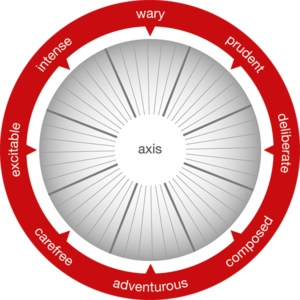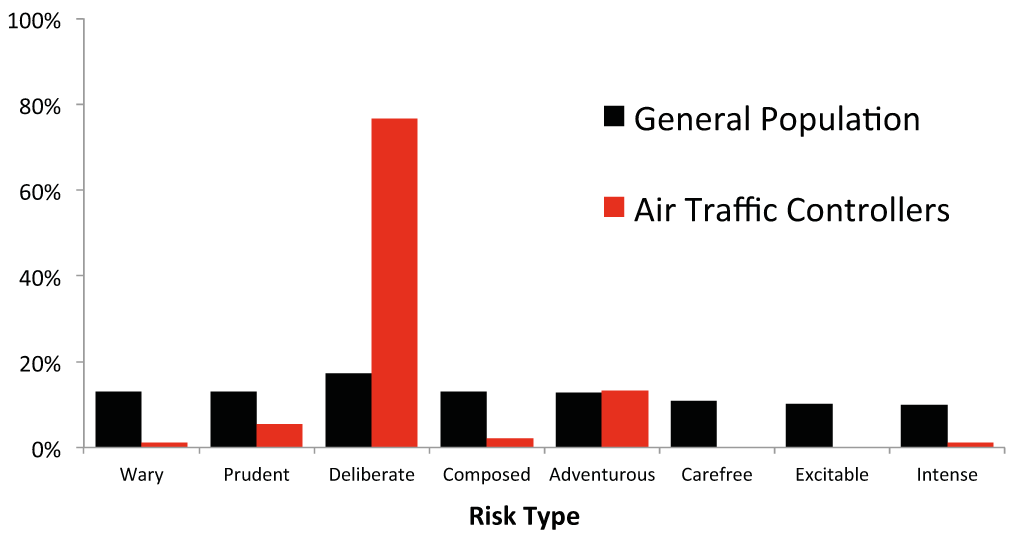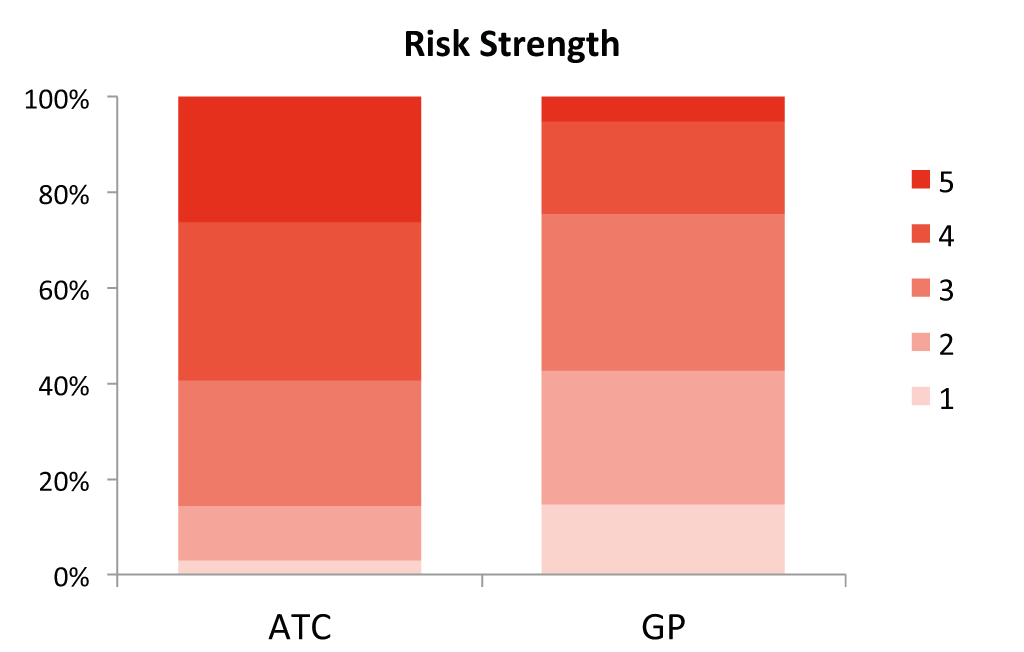The role of ‘Air Traffic Controller’ has few rivals when it comes to handling high-stake risks on a day-to-day basis, so it is unsurprising that risk management is regarded as a priority. Traditional approaches focus upon training, operational procedures, work environments, regulations, and employee health, and a plethora of models, tools, and techniques have emerged as a result.
The significance of risk in many different professions has been analysed by risk management professionals and air traffic controllers are no exception. Despite this flurry of activity, the interaction between personality and risk has remained comparatively unexplored. This raises questions about the traditional risk management approach, and whether it just tackles symptoms of risky behaviour without addressing the underlying cause.
Personality assessments can provide excellent insights into how individuals approach work-based tasks, interact with colleagues, and react to the various pressures inherent in a role. However, the high levels of pressure and risk associated with the responsibilities of air traffic controllers justify the use of an assessment tool with a greater focus on this key area.
When we were approached by a major employer of air traffic controllers and asked to provide psychological insight into their most recent on going recruitment process, we recognised the need to provide a personality assessment that would reflect the central role that risk represents to the industry.
We adopted a personality-orientated approach that addressed individuals’ reactions, propensities, and aversions towards risk. Whilst some links could be drawn between existing personality assessments and risk, we found the levels of inference required by their panoramic perspective unsuited to the task. When an entire profession and their clientele live or die, quite literally, by how successfully they deal with risk, we needed an assessment that gave priority and focus to the risk aspects of personality.
Methodology
The highly influential Five Factor Model of personality (FFM) is derived ultimately from the language that people use to describe themselves and others. When thinking about risk from a vocabulary perspective, it soon becomes apparent that a significant part of that FFM lexicon will be words that differentiate people in terms of their disposition towards risk. As the first publishers of a UK edition FFM personality questionnaire, Psychological Consultancy had a particular appreciation of the links between personality psychometrics, language and the way people perceive, process, and react to risk in their day-to-day lives.
This approach lead to a review of risk related findings from many FFM studies, and to the identification of 24 FFM sub-themes relevant to risk disposition. Positive and negative items were created for each theme, and the resulting questionnaire was administered to a working adult sample encompassing 328 participants from a wide spectrum of occupations. Factor analysis indicated that 18 of these themes fit into a framework of four factors, which were given working titles of Calm, Emotional, Measured, and Daring. The opposing nature of the former two and latter two factors allowed us to create two highly reliable bi-polar scales, labelled Calm:Emotional and Measured:Daring. Arranged orthogonally to cross at their means, this effectively created four ‘compass’ points.
To account for potential interaction between extreme scores on these two scales (i.e. high/low scores on both), we created additional ‘compass points’ equidistant between each of the four originals, creating a circular model with 8 points that we designated as ‘Risk Types’. We were also able to identify an individual’s ‘Risk Type Strength’, which is represented by their proximity from the edge of the circle. A Risk Strength of 0 would signify an ‘Axial’ position close to the centre (no clearly defined Risk Type), whilst a Risk Strength of 5 would place the individual on the outer perimeter (highly influenced by their Risk Type).

The development of this eight-pointed model heralded the inception of the Risk Type Compass, a psychometric tool that assigns participants to one of eight distinct Risk Types based upon their responses to a 102-item questionnaire.
The Risk Type Compass has been administered to over 8,000 people. Perhaps the most exciting and notable finding has been the relatively even distribution of participants (ranging from 9% to 15%) amongst the 8 Risk Types. The utility of this finding is increased when viewed in conjunction with the distinctiveness, or strength, of each Risk Type. When Risk Type and the strength of its influence are viewed together, differentiation in roles and industries garner added significance. Within the Air Traffic Control industry, we were able to administer the Risk Type Compass assessment to 90 candidates taking part in the latter stages of an industry-led recruitment programme.
Results
We collated results for the 90 Air Traffic Controller candidates and compared them against our General Population (GP) sample of 8,000 participants to identify how the 8 Risk Types were distributed across the sample. The figure below presents the dramatic result of this comparison.

When Axial participants (i.e. no distinct Risk Type) were removed, the proportion of Deliberate Risk Types in the GP sample stands at 17%, yet over 75% of our Air Traffic Controller sample fell into this category. It was equally notable that none of the sample was classified as Carefree or Excitable Risk Types, with the Adventurous Risk Type coming a very distant second with 13% of the sample.
Individuals designated as Deliberate Risk Types will have high scores at the Measured and Calm ends of the underling scales. They will typically appear calculated, sure-footed, and not easily unnerved, but will typically test the ground thoroughly and do things ‘by the book’. Their approach will be analytical and business-like, and they will want to plan ahead and be well prepared. Their position opposite the Excitable Risk Type suggests an absence of the characteristics of that Risk Type, described as making decisions fuelled by enthusiasm for exciting ideas and opportunities, but tempered by pessimism and sensitive risk antennae. They tend to wrestle over decisions, but go in deep once committed.
If the high distribution of Deliberate Risk Types in the Air Traffic Controller sample represented the research’s first major finding, the propensity of Risk Strength reflects its second. This indicates how closely the individual is likely to conform to their Risk Type description. A comparison with the GP control group is presented in the figure below.

When compared against Deliberate Risk Types from the GP sample, the Air Traffic Controller group were five times more likely to fall into the strongest ‘strength 5’ category. Further analysis indicated that nearly 60% of the Deliberate Risk Types in the sample were placed in either strength 4 or 5 categories, compared with fewer than 25% of Deliberate Risk Types from the GP control group. This result indicates that, not only is the Air Traffic Control sample risk disposition appropriately captured by the Deliberate Risk Type, but also that the associated characteristics are likely to have a very considerable influence upon how they will behave towards risk and perform in their jobs.
Conclusions
An individual’s Risk Type is a reflection of their perception, tolerance and propensity towards risk taking, and this insight can be applied in various ways. When used in combination with other metrics from the Air Traffic Controller recruitment process, the Risk Type Compass has generated greater understanding and facilitated bespoke and targeted discussion with candidates around a variety of risk-related topics that are central to the role.
The insight provided by the Risk Type Compass is also well suited to development contexts; it helps in identifying various strengths and challenges that influence how an individual approaches and completes tasks. An example for the Deliberate Risk Types in the Air Traffic Control industry could be the need to appreciate that, whilst their calm and business-like manner is likely to prove an extremely valuable asset in coping with the stress of their role, that same high level of calmness may also prove a barrier to communicating the potential urgency of a situation to pilots.
The authors
Dr Simon Toms is a Consultant Psychologist with Psychological Consultancy Ltd, and focuses upon the research, development, and validation of PCL tools.
Geoff Trickey is the Managing Director of Psychological Consultancy Ltd, and creator of the Risk Type Compass.